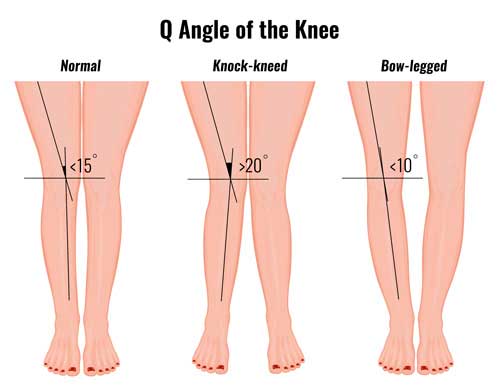The Q angle of the knee is a measure of the angle between the thigh muscles and patella tendon. It is important for knee rehabilitation as an abnormal q angle can lead to patella tracking problems.
Medically reviewed by Dr. Chaminda Goonetilleke, 31st Dec. 2021
What is the Q angle of the knee?
The Q angle of the knee is a measurement of the angle between the quadriceps muscles and the patella tendon. It provides useful information about the alignment of the knee joint.

How to measure the Q angle
You will need a long-arm goniometer. You can measure the Q angle either laying down or standing up. Standing is usually more suitable. This is due to the normal weight-bearing forces applied to the knee joint during daily activity.
- Place the centre of the goniometer over the centre of the patella.
- Position the bottom arm in line with the patella tendon and tibial tuberosity.
- Next, position the upper arm so that it points directly at the anterior inferior iliac spine (AIIS). This is where the rectus Femoris attaches to the Ilium.
- The small angle of the goniometer is the Q angle.
What is normal?
Normal for men is 14 degrees and for women is 17 degrees. Women usually have a higher Q angle due to their naturally wider pelvis. If measured laying down the angle will be 1-3 degrees lower.
A high Q angle means mal-tracking of the patella is likely. As a result it does not travel over the front of the knee joint as it should.
Over time this causes microtrauma to the cartilage on the rear of the patella. Eventiually this becomes pain, often known as anterior knee pain, patellofemoral pain or chondromalacia patella.
Having over-pronated feet also places additional strain on the Q angle due to excessive internal rotation of the tibia.
How do you decrease the Q angle?
The first step is to correct any over-pronation at the feet using orthotics. There is no manipulation or adjustment (such as you might receive at a chiropractor) to reduce Q angle.
Your aim is to achieve correct biomechanics through a rehabilitation program which focusses on restoring flexibility to tight muscles and strengthening weak ones. Tight muscles are often the calf muscles, hamstrings and quadriceps.
The Vastus medialis oblique, known as VMO (vastus medialis oblique) is usually weak.
These fibres play an important role in controlling the position of the patella. Therefore, both muscle strength and timing of how they contract is important.
Read more on VMO knee strengthening.







